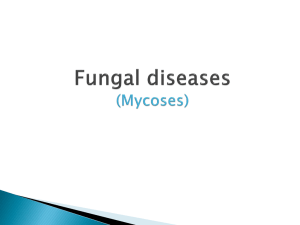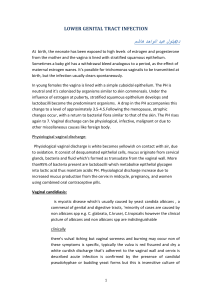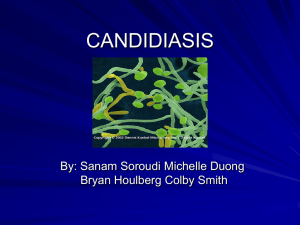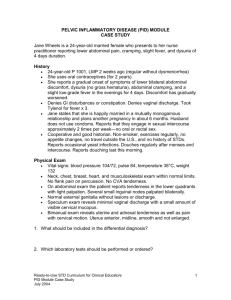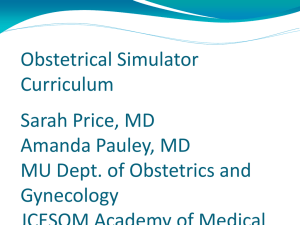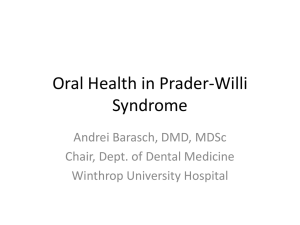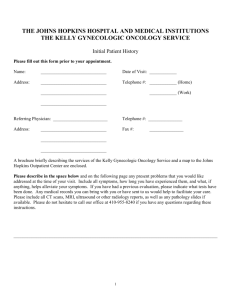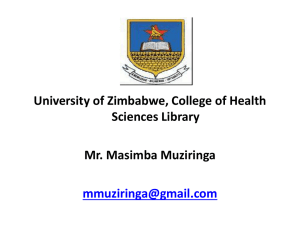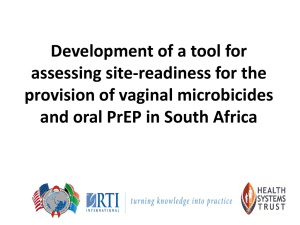1349196720new paper
advertisement
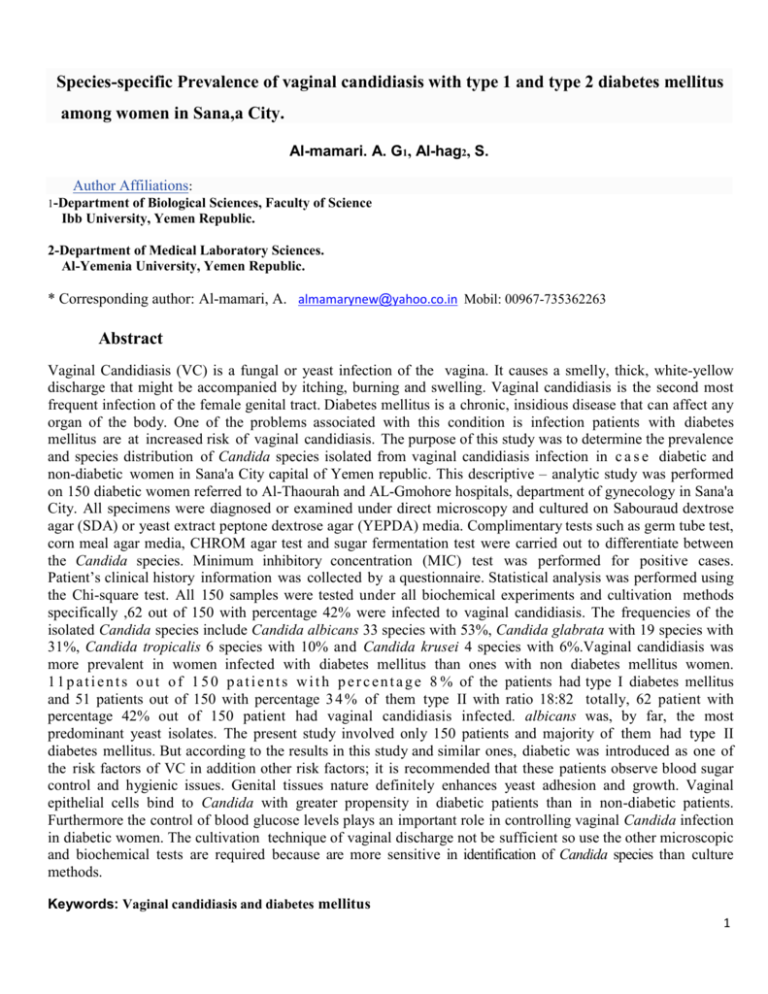
Species-specific Prevalence of vaginal candidiasis with type 1 and type 2 diabetes mellitus among women in Sana,a City. Al-mamari. A. G1, Al-hag2, S. Author Affiliations: 1-Department of Biological Sciences, Faculty of Science Ibb University, Yemen Republic. 2-Department of Medical Laboratory Sciences. Al-Yemenia University, Yemen Republic. * Corresponding author: Al-mamari, A. almamarynew@yahoo.co.in Mobil: 00967-735362263 Abstract Vaginal Candidiasis (VC) is a fungal or yeast infection of the vagina. It causes a smelly, thick, white-yellow discharge that might be accompanied by itching, burning and swelling. Vaginal candidiasis is the second most frequent infection of the female genital tract. Diabetes mellitus is a chronic, insidious disease that can affect any organ of the body. One of the problems associated with this condition is infection patients with diabetes mellitus are at increased risk of vaginal candidiasis. The purpose of this study was to determine the prevalence and species distribution of Candida species isolated from vaginal candidiasis infection in c a s e diabetic and non-diabetic women in Sana'a City capital of Yemen republic. This descriptive – analytic study was performed on 150 diabetic women referred to Al-Thaourah and AL-Gmohore hospitals, department of gynecology in Sana'a City. All specimens were diagnosed or examined under direct microscopy and cultured on Sabouraud dextrose agar (SDA) or yeast extract peptone dextrose agar (YEPDA) media. Complimentary tests such as germ tube test, corn meal agar media, CHROM agar test and sugar fermentation test were carried out to differentiate between the Candida species. Minimum inhibitory concentration (MIC) test was performed for positive cases. Patient’s clinical history information was collected by a questionnaire. Statistical analysis was performed using the Chi-square test. All 150 samples were tested under all biochemical experiments and cultivation methods specifically ,62 out of 150 with percentage 42% were infected to vaginal candidiasis. The frequencies of the isolated Candida species include Candida albicans 33 species with 53%, Candida glabrata with 19 species with 31%, Candida tropicalis 6 species with 10% and Candida krusei 4 species with 6%.Vaginal candidiasis was more prevalent in women infected with diabetes mellitus than ones with non diabetes mellitus women. 1 1 p a t i e n t s o u t o f 1 5 0 p a t i e n t s w i t h p e r c e n t a g e 8 % of the patients had type I diabetes mellitus and 51 patients out of 150 with percentage 3 4 % of them type II with ratio 18:82 totally, 62 patient with percentage 42% out of 150 patient had vaginal candidiasis infected. albicans was, by far, the most predominant yeast isolates. The present study involved only 150 patients and majority of them had type II diabetes mellitus. But according to the results in this study and similar ones, diabetic was introduced as one of the risk factors of VC in addition other risk factors; it is recommended that these patients observe blood sugar control and hygienic issues. Genital tissues nature definitely enhances yeast adhesion and growth. Vaginal epithelial cells bind to Candida with greater propensity in diabetic patients than in non-diabetic patients. Furthermore the control of blood glucose levels plays an important role in controlling vaginal Candida infection in diabetic women. The cultivation technique of vaginal discharge not be sufficient so use the other microscopic and biochemical tests are required because are more sensitive in identification of Candida species than culture methods. Keywords: Vaginal candidiasis and diabetes mellitus 1 INTRODUCTION Diabetes mellitus is a chronic, insidious disease that can affect any organ of the body. One of the problems associated with this condition is infection (Malazy et al.,2007). Patients with diabetes mellitus are at increased risk of vaginal candidiasis (Goswami et al., 2006). Vaginal candidiasis is the second most frequent infection of the female g e n i t a l t r a c t (Sobel, 1 9 8 5 ; Grigoriou et al., 2006). Up to 75% of all w o m e n w i l l experience fungal vaginitis at some point in the lives, and approximately 40 to 50% will experience a second episode of this disease (Ferrer, 2000; Moreira and Paula, 2006). One cause of recurrent VC is hyperglycemia. Candida infection in the vagina can cause a smelly, thick, white–yellow discharge that might be accompanied by itching, burning a n d s w e l l i n g . It c a n a l s o m a k e walking, urinating or sex very painful (Bohanon, 1998). Since t h e s y m p t o m s o f v a g i n a l c a n d i d a s i s are n o t specific to the infection, diagnosis cannot be made solely on the basis of history and physical examination. But the clinical diagnosis of vaginal candidiasis should always be 50% of patients with culture positive symptomatic vaginal candidosis will have negative microscopy. Thus, although routine cultures are not necessary if microscopy is positive, vaginal culture should be done in symptomatic women with negative microscopy (Sobel, 2007).Candida albicans is the most common species isolated in such an infection in diabetics as well as in non- diabetics. Recently, vaginal infection with non C. albicans species has been reported with increasing frequency in non-diabetic groups, possibly due to widespread and empirical use of antifungal drugs (Goswami et al., 2000; Spinillo et al., 1995; Sobel et al.,1998). In addition to diabetes, other risk factors for recurrent vaginal candidosis are genetic, pregnancy, the use of oral contraceptives or antibiotics, immune disorders, behavioral factors such as sexual activity and HIV (Sobel, 2007). The aim of this study is to determine the prevalence rate of vaginal candidiasis in diabetic women in Sana,a City. MATERIALS AND METHODS This descriptive–analytic study was performed on 150 diabetic women in Sana,a City. According to world health organization (WHO), diabetic affliction criterion was fasting blood sugar (FBS) higher than 140 mg/dl in two separate times. We administered a questionnaire to obtain information about: age, occupation, education, symptoms, type of diabetes mellitus, and duration of diabetes mellitus, FBS and glycosylated hemoglobin (HbA1C).The clinical symptoms were not seen on all of the patients. Two sterile cotton-tipped swabs were used to collect discharge from high vagina and sent it to the laboratory without delay. The swab was used to fungal culture (culture on Sabouraud,s dextrose broth supplemented with 50 mg chloramphenicol) then incubation at 37°C the apertures of the burettes for growing the fungus were viewed by bare-edges after 24 48hurs. The positive sample it was determine the presence of yeast by methyleneblue staining in direct microscopy (Figure 2). On the other hand pure culture on SDA media it was prepared for other diagnosis (Figure 1). The diagnosis of VC was based on pesudohyphae and chlamydospores identified by microscopic examination and on candida growth on high vaginal swab culture. Isolated strains were identified using the germ tube test (Figure 3). CHROM agar test and sugar fermentation test. The susceptibility in vitro to Fluconazole was performed by the National Committee for Clinical Laboratory Standard (NCCLS) (1997) document M27-A. Serial dilution was gained from 64 to 0.125 μg/ml of Fluconazole. A tube was used as a positive control (without antibiotic). Anything which caused disdiffidently was considered as a resistance against that density. MIC for Fluconazole was defined as the first concentration at which no growth was detected (Goswami et al., 2006; Goswami et al., 2000). Statistical analysis was performed using the Chisquare test and a p-value < 0/05 was considered as significant. 2 RESULTS 150 diabetic women were eligible for this study. Their age varied from 25 to75 years (51±9 ) with mean fasting blood sugar level 191 ± 67 mg/dl, and their mean duration of diabetes mellitus was 12 ± 6years. The duration of diabetes in 50% of them was ≤ 7 and in remaining 50% was > 7 years. 1 1 c a s e o u t o f 1 5 0 c a s e s w i t h p e r c e n t a g e 8 % of the patients had type I diabetes mellitus and 51 cases out of 150 with percentage 3 4 % of them type II with ratio 18:82 from totally of 62 out of 150 with 42% vaginal candidiasis patients had infected. Mean glycosylated hemoglobin level in these patients was 7/3 ±2. 58% of the patients had clinical symptoms such as burning, itching and discharge and 42% of them had no symptoms. Regarding educational level, 76% of our patients were illiterate or had a high school degree, and 24% were college graduates. 81% of patients were housewives, and 19% were working women. The prevalence rate of Vaginal candidiasis patients according to direct microscopic, biochemical tests and mixture culture reported 62 out of 150 patients with 42%. While 98 out of 150 patients were no infected with vaginal candidiasis.The species of Candida isolated in these patients consisted of C.albicans 33 species with 53% , C. glabrata 19 species with 31%, Candida tropicalis 6 species with 10%, and Candida krieuse 4 species with 6% which C. albicans was the most predominant yeast isolate (Table1). In the present study, we found a significant statistical difference between vaginal candidiasis and occupation, education, but we did not find a significant statistical difference between vaginal candidiasis and symptoms, duration of diabetes mellitus and glycosylated hemoglobin (HbA1C), on the other hand we found a significant statistical difference between vaginal candidiasis and age, type of diabetes mellitus and fasting blood sugar (FBS) (Table 2). Results of the in vitro fungal susceptibility test showed that there existed no significant difference in the Fluconazole susceptibility between C. albicans and non- C. albicans candidiasis (P = 1/000) (Table 3). DISCUSSION Although it is commonly believed that vaginal candidiasis in most of the diabetic women is more prevalent than the non-diabetic ones, its conservative relation is not yet known (Reed, 1992; Sobel et al., 1998). Vaginal yeast infection is usually diagnosed on the basis of clinical symptoms, direct microscopic examination and vaginal discharge culture. The microscopic examination of the clinical material is rapidly performed and may identify the presumptive etiologic agent, but vaginal culture is indispensable to confirm the diagnosis by microscopic examination. Grigoriou et al. (2006) strongly believed that diagnosis must be made thorough vaginal cultures with microscopic and biochemical examination. Different studies indicated that vaginal candidiasis infection is more common in women with diabetes than in the normal population (Malazy et al., 2007; Scudamore et al., 1992; Sobel, 1993). The prevalence rate ranged from around 7 to more than 50% (Bohanon, 1998; Davis, 1969; Malazy et al., 2007), and most of which was attributed to C. albicans (Duerr et al., 1997; Malazy et al., 2007; Otero et al., 1998). Goswami et al. (2006) reported the prevalence rate of 46% in 78 diabetic women. Peer et al. (1993) reported the prevalence rate of the vaginal candidiasis infection 42% in 111 diabetic women and so these results concordant with our study results whereas we reported the prevalence rate of the vaginal candidiasis infection 62 with 42% out of 150 diabetic women studied. These statistics showed simple different in prevalence rates of vaginal candidiasis in diabetic women. Likely reasons for this difference c o u l d be attributed to lack of control on the blood sugar, and also to the use of unsuitable antifungal agents. Nowadays, because of prevalence of the vaginal candidiasis infection and drug resistance o f some Candida species, it is necessary to determine disease causing factors separated from the waste. In this study, which was similar to other studies like Antony et al. (2009), Corsello et al. (2003), Grigoriou et al. (2006), Maccato and Kaufman (1991) and Peer et al. (1993), the most separated species from the patients was C. albicans. The first step in establishing a yeast infection is bonding to the vaginal mucosa. It seems that C. albicans is more adhesive than other non-C. albicans species. This could be considered as one of the likely reasons that this 3 species are predominant rather than non-C. albicans species (Grigoriou et al., 2006; Maccato and Kaufman,1991) unlike other studies on the prevalence of non-C. albicans species that has increasing species (Duerr et al.,1997; Goswami et al., 2006; Otero et al., 1998; Sobel et al., 1998). A high rate of prevalence of non-C. albicans species was not achieved in our study. Goswami et al. (2000) reported the prevalence rate of non-C. albicans species 39% with the predominant species C. glabrata in diabetic women. Sobel and Malazy (1998, 2007) stated the probable causes of higher non-C. albicans species: the short duration of use for oral or local anti-Candida regimens; the widespread use of over-the-counter antifungal agents. Similar to the study by Malazy et al. (2007), a significant statistical difference not found in this study. instead, a or relationship between positive vaginal Candida culture and symptoms, duration of diabetes mellitus and glycosylated hemoglobin but was discovered significant statistical difference between positive vaginal Candida culture and fasting blood sugar, education level and occupation. Bohanon (1998) stated that the main causes of this state of affairs are hyperglycemia. Increased glucose levels. In the current study, we did not find a significant statistical difference in the Fluconazole susceptibility between C. albicans and non-C. albicans candidiasis. Prescribing general d r u g for a long duration causes a drug resistance. Therefore, awareness of the drug resistance Candida separated from vaginitis against the general anti-Candida drug is needed to cure involving cases properly. Table 1. Frequency of different Candida species isolated from diabetic women. Candida species C. albicans C. glabrata C. tropicalis C. krusei Total Positive case (n) 33 19 6 4 62 Percentage 53% 31% 10% 6% 100 4 Table 2. Predisposing factors for vagin al candidiasis infection in diabetic women. Predisposing factors Positive case (n) Percentage (%) P value Age : ≤ 40 years 14 23 > 40 years 48 77 Working 12 19 Housewife 50 81 College 15 24 illiterate, high school 47 76 Yes 19 30 No 43 70 Duration of diabetes mellitus : ≤ 7 years 39 63 > 7 years 23 37 < 7% 38 61 ≥ 7% 24 39 < 200 mg/dl 12 19 ≥ 200 mg/dl 50 81 11 18 51 82 0/02 Occupation : 0/004 Education : 0/004 Symptoms : 0/414 0/319 HbA1C : 0/318 FBS : Diabetes mellitus Type I Type II 0/004 0/003 5 Figure 1-Candida albicans on Sabouraud- Dextrose Agar at 48h at 37C. Antifungal agent (Fluconazole) Candida species(n)* Mean MIC C. albicans (10) 0.60 Non-C. albicans (10) 0.57 * Number of selected isolate for the test. P value 1/000 1/000 Table 3. Antifungal susceptibilities of the selected C. albicans and non-C. albicans isolates. 6 Figure 3- Germ tube formation in human serum ×40 Figure 4- Chlamydospore formation in corn meal broth media with Gram stain at 24 hours in diabetic women cases ×40 http://www.google.com/url?source=imgres&ct=img&q=http://3.bp.blogspot.coa8wYD4D 7 A&ved=0CAQQ8wc4Bg&usg=AFQjCNFYuEkOrZWYkG__VJdS82MWMkSwUg Conclusion Figure-2 Photomicrograph of budding blastoconidia in Candida species. Note (arrows). Conclusion The present study involved only 150 patients and majority of them had type II diabetes mellitus. But according to the results in this study and similar ones, diabetic was introduced as one of the risk factors of VC in addition other risk factors; it is recommended that these patients observe blood sugar control and hygienic issues. Genital tissues nature definitely enhances yeast adhesion and growth. Vaginal epithelial cells bind to Candida with greater propensity in diabetic patients than in non-diabetic patients. Furthermore the control of blood glucose levels plays an important role in controlling vaginal Candida infection in diabetic women. In the present study, also a significant statistical difference between positive vaginal Candida culture and type of diabetes mellitus was found. Similar to the findings of the study carried out by Malazy (2007), in this study, it was found that most of the women w i t h v a g i n a l c a n d i d i a s i s infection suffered from type II diabetes, mostly due to the age of patients. The mean age of them was 51 years and they were mainly categorized into an age range over 40 years. While type I diabetes occur before 30, it should also be noted that the prevalence rate of vaginal candidiasis infection occurs during intercourse sexual and pregnancy. A significant statistical difference between vaginal candidasis infection and education and Occupation was found in this study, which could be attributed to the observance of genital hygiene and low level of glucose in diet. We did not find a significant statistical difference between infectious vaginiti and glycosylated hemoglobin, because acute infections such as vaginitis often occur during the hyperglycemic state, but glycosylated hemoglobin reflects the mean blood glucose level over the previous 3 months (Malazy et al., 2007). In this study, we showed no significant difference in the fluconazole susceptibility between C. albicans and nonC. albicans candidiasis so other studies are needed for confirm that. 8 REFERENCES Antony G, Saralaya V, Bhat K, Shalini M, Shivananda PG (2009). Effect phenotypic switching on expression of virulence factors by candida albicans causing candidiasis in diabetic patients. Iberoam. J. Micol.,26(3): 5-202. Bohanon NJ (1998). Treatment of volvovaginal candidasis in patients with diabetes. Diabetes. J. Care, 21: 6-451. Corsello S, Spinillo A, Osnengo G, Penna C, Guaschino S, Beltrame A, Blasi N, Festa A (2003). An epidemiological survey of vulvovaginal candidiasis in Italy. Eur. J. Biol., 110(1): 66-72. Davis BA (1969). Vaginal moniliasis in private practice. Obstet. J. Gynecol., 34: 5-40. Duerr A, Sierra MF, Feldman J, Clark LM, Ehrlich I, Dehovitz J (1997). Immune Compromise and prevalence of Candida volvovaginitis in human Immunodeficiency virus infected women. Obstet. J. Gynecol.,90: 6-252. Ferrer J (2000). Vaginal candidosis: Epidemiological and etiological factors. Inter. J. Gynecol., 71: 7-21. Goswami D, Goswami R, Banerjee U, Dadhwal V, Miglani S, Lattif AA, Kochupillai N (2006). Patten of Candida species isolated from patients with diabetes mellitus and vulvovaginal candidiasis and their response to single dose oral fluconazole therapy. Infect. J., 52(2): 7-111. Goswami R, Dadhwal V, Tejaswi S, Datta K, Paul A, Haricharan RN, Banerjee U, Kochupillai N (2000). Species-specific prevalence of Vaginal candidiasis among patients with diabetes mellitus and its relation to ther glycaemic status. Infect. J., 41(2): 6-162. Grigoriou O, Baka S, Makrakis E, Hassiakos D, Kapparos G, Kouskouni E (2006). Prevalence of clinical vaginal candidiasis in a university hospital and possible risk factors. Eur. J. Biol., 126(1): 5-121. Maccato ML, Kaufman RH (1991). Fungal vulvovaginitis. Curr. J.Gynecol., 3(6): 52-849. Malazy OT, Shariati M, Heshmat R, Majlesi F, Alimohammadian M, Moreira D, Paula C (2006). Vulvovaginal candidiasis. Inter. J. Obstet.,92: 266-267. National Committee for Clinical Laboratory Standards (NCCLS). (1997). Reference Method for broth dilution antifungal susceptibility testing of yeast. Approved standard. NCCLS document M27-A. Villanova, PA.Otero L , P a l a c i o V , C a r r e n o F , Mendez F J , V a z q u e z F ( 1998).Vulvovaginal candidiasis in female sex workers. Int. J. AIDS., 9: 30-526. Peer AK, Hoosen AA, seedat MA, van-den-Ende J, Omar MA (1993). vaginal yeast infections in diabetic women. Afr. J. Med., 83: 9-727. Qingkai D, Lina H, Yongmei J, Hua S, Jinho L, Wenjie Z, Chuan S, Hui Y (2010). An epidemiological survey of bacterial vaginosis, Vulvovaginal candidiasis and trichomoniasis in the Tibetan area of Sichuan Province, China. Eur. J. Biol., 150: 207-209. Reed BD (1992). Risk factors for candida vulvovaginitis. Surv. J. Gynecol., 47(8): 60-551. Scudamore JA, Tooley PJ, Allcorn RJ (1992). The treatment of acute and chronic vaginal 9 candidacies. Br. J. Pract., 46: 3-260. Sobel JD (1985). Epidemiology and pathogenesis of recurrent vulvovaginal candidiasis. Am. J. Gynecol., 152: 35-924. Sobel JD (1985). Epidemiology and pathogenesis of recurrent vulvovaginal candidiasis. Am. J. Gynecol., 152: 35-924. Sobel JD (1993). Candidal vulvovaginitis. Clin. J. Gynecol., 36: 65-153. Sobel JD (2007). Vulvovaginal candidosis. Lancet. J., pp. 71-369. Sobel JD, Faro S, Force RW, Foxman B, ledger WJ, Nyirjesy PR, Reed RD, Summers PR (1998). Vulvovaginal candidiasis: Epidemiologic, diagnostic, and therapeutic considerations. Am. J. Gynecol., 178: 203-211. Spinillo A, Capuzzo E, Egbe TO, Baltaro F, Nicola S, Piazzi G (1995). Torulopsis glabrata vaginitis. Obstet. J. Gynecol., 85: 993-998. Wentworth BB (1998). Diagnostic Procedures for Mycotic and Parasitic Infection, 7th Washington, DC: American Public Health Association. ed, 10
